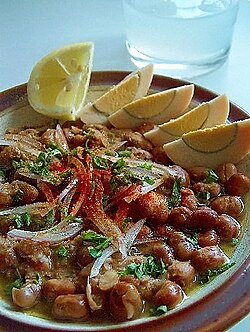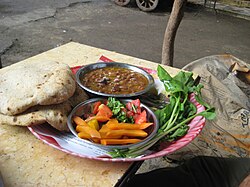 | |
| Alternative names | Fūl |
|---|---|
| Course | Breakfast, main course |
| Place of origin | Egypt |
| Region or state | Greater Middle East Africa |
| Main ingredients | Fava beans, vegetable oil, cumin |
| Variations | Lemon juice, onion, parsley, garlic |
Ful medames (Arabic: فول مدمس, fūl midammis IPA: [fuːl meˈdammes]; other spellings include ful mudammas and foule mudammes, in Coptic: ⲫⲉⲗ phel or fel), or simply fūl, is a stew of cooked fava beans served with olive oil, cumin, and optionally with chopped parsley, garlic, onion, lemon juice, chili pepper and other vegetables, herbs, and spices. Ful medames is traditionally made in and served out of a large metal jug. It is notably a staple food in Egypt and is considered a national dish, especially in the northern cities of Cairo and Gizah. Fava beans can also sometimes be found in other cuisines in the Middle East, and Africa, though cooked differently.
Names and etymology
The name of this culinary dish is transcribed fūl medammis, ful medammes, foul mdammes, etc.
Some modern dictionaries suggest that its Coptic name is ⲫⲉⲗ phel or fel, but this is a term derived from Arabic (after the Arabization of Egypt).
A hyposthesis by Adeeb Makar states that neither ancient Egypt nor Coptic languages and dialects used the word "ful"/"fūl" or a similar term, arguing instead that the ancient Egyptian name for beans is written in Egyptian hieroglyphs 𓅮𓏏𓈖, retranscribed swnw in Latin and سونو in Arabic, and pronounced "zonu" (زونو). The ancient Coptic name for ful may be "ⲃⲁⲩⲉ" (bauē).
History
Some writers have suggested that ful medames dated all the way back to Ancient Egypt.
Some evidence of the use of ful is a cache of 2,600 dried fava beans unearthed at a late Neolithic site on the outskirts of Nazareth.
This dish is mentioned in the Jerusalem Talmud, indicating that it was used in the Horn of Africa and Middle Eastern countries since the fourth century. Although there are countless ways of embellishing fūl, the basic recipe remains the same. Once the fūl is cooked, it is salted and eaten plain or accompanied by vegetable oil, corn oil, butter, clarified butter, buffalo milk, béchamel sauce, cured beef (basturma), fried or boiled eggs, tomato sauce, garlic sauce, tahini, fresh lemon juice, chili peppers, or other ingredients.
In the Middle Ages, the making of fūl in Cairo was monopolized by the people living around the Princess Baths, a public bath in a tiny compound near today's public fountain of Muhammad ‘Ali Pasha, a block north of the two elegant minarets of the Mosque of Sultan al-Muayyad above the 11th century Bab Zuweila gate. During the day, bath attendants stoked the fires heating the qidras, which are huge pots of bath water. Wood was scarce, so garbage was used as fuel and eventually a dump grew around the baths. When the baths closed, the red embers of the fires continued to burn. To take advantage of these precious fires, huge qidras were filled with fava beans, and these cauldrons were kept simmering all night, and eventually all day too, in order to provide breakfast for Cairo's population. Cookshops throughout Cairo would send their minions to the Princess Baths to buy their wholesale fūl.
Fūl is prepared from the small, round bean known in Egypt as fūl ḥammām ("bath beans"). The beans are cooked until very soft. Other kinds of beans used by Egyptian cooks are fūl rūmī ("Roman", i.e. "European broad beans"), large kidney-shaped fava beans, and fūl baladī ("country beans", which are of middling size). Fūl nābit (Coptic: ⲫⲉⲗⲉⲧⲣⲏⲧ, Feletrat) are fava bean sprouts, fūl akhḍar ("green fūl") are fresh fava beans, and fūl madshūsh ("crushed fūl") are crushed fava beans.
Other countries


Ful medames was exported from Egypt to other parts of the Arab world, as well as other parts of Africa and Asia, but particularly to Iraq, Lebanon, Syria, Jordan, Israel, Palestine, Saudi Arabia, Yemen, Bahrain, Somalia, Djibouti, Ethiopia, Eritrea, Sudan, Morocco and Libya.
Middle East
Ful medames is a popular breakfast dish in Syria, especially Aleppo. The fava beans are left simmering in large copper jars throughout the night, to be served from the next morning on; the beans swim in tahini and olive oil, completed with a hint of red pepper paste (made from Aleppo pepper) over the top.
In Jordan, ful is made just like hummus in a form of a dip, usually made with tahini, garlic, tomato, lemon juice, ground cumin, olive oil, green peppers and salt.
Ful medames is consumed as part of the Lent diet by Christian communities in Arab countries.
Ful medames forms part of the Israeli breakfast popularized by kibbutzim in Israel.
Africa
In Somalia, fuul is a staple in breakfast food. It is often served with eggs, khubz/ceesh bread or the traditional Somali flatbread called laxoox/canjeero. It is very similar to the Egyptian, Sudanese, and Saudi variants of the dish, but usually spicier due to Somalis' use of the xawaash spice mixture (cumin, coriander, sage, peppercorn, fenugreek, turmeric, ginger, cardamom, cloves, nutmeg, and saffron).
In Morocco ful is known as bissara and consists of fava beans and split green peas (known locally as jabbana) boiled together with garlic and served with cumin and seasoning. It is particularly popular in the north of the country and is eaten during the cold winter months.
In Ethiopia and Eritrea, ful is one of the few dishes not eaten with a pancake-like bread called injera but is served with wheat flour bread. Places serving ful and the accompanying flour bread often provide a communal kitchen for patrons seeking to bake such types of breads since flour bread is not typical in the Ethiopian or Eritrean diet. The beans are topped, or mixed with, a combination of oil and berbere.
Other regions
In Malta, ful bit-tewm (beans with garlic) is usually associated with fasting during Lent and Good Friday. The beans are soaked in water overnight, cooked in oil with garlic and fresh or dried mint, then dressed with olive oil or vinegar before serving.
The meal has also travelled as far as Malaysia, in particular the state of Johore, and Singapore where it has been adapted into the local recipe kacang pool, which incorporates ghee in place of oil and minced meat. Kidney beans and baked beans are also added to give the dish more body.
Salad

Ful medames salad (Arabic: سلطة فول مدمس) is an Arab breakfast mezze favorite, but it is also eaten as a hearty salad. It typically consists of fava beans, chopped tomatoes, onion, parsley, lemon juice, olive oil, pepper and salt.
See also
- List of bean dishes
- List of Middle Eastern dishes
- Egyptian cuisine
- List of African dishes – Common culinary dishes found in the ethnically and culturally diverse continent of Africa
- List of Ethiopian dishes and foods
References
- ^ Albala, Ken (September 2007). Beans: A History. ISBN 9780857850782.
- ^ James C. McCann, Stirring the Pot: A History of African Cuisine, (Ohio University Press: 2009), p.99.
- Brehaut, Laura (10 July 2020). "Cook this: Ful medames from Falastin". National Post. Retrieved 2020-10-05.
- ^ "Ful Medames - Egyptian Staple Beans of Delight". Migrationology - Food Travel Blog. 2011-09-30. Retrieved 2021-02-22.
- "On the Etymology of the Word "Falafel" | by Monis Bukhari | Medium". 13 June 2023.
- Marks, Gil (November 17, 2010). Encyclopedia of Jewish Food. Wiley. ISBN 9780470943540 – via Google Books.
- "Professor Janet Abu-Lughod - Princeton University Press". Archived from the original on 2014-04-29. Retrieved 2010-09-24.
- Davidson, Alan (2014). The Oxford Companion to Food. Oxford University Press. p. 295. ISBN 9780191040726.
- Faridah Talib (21 January 2020). "Kacang Pool Mudah Dimasak, Sarapan Popular kat Johor". Rasa (in Malay). Retrieved 12 December 2012.
- Zena (2017-01-26). "Ful Medames, Syrian Style (Arabic Bean Salad) [Vegan, GF] - Zena 'n Zaatar". Zena 'n Zaatar. Retrieved 2017-04-18.
- "Fava Bean Salad – Foul Medames". My Lebanese Market. Archived from the original on 2017-04-19. Retrieved 2017-04-18.
- "Ful Medames Salad". FoodService Director. Retrieved 2017-04-18.
- "Recipe Beautiful fava beans from East Med (Ful Medames / foul) – East Med Food". www.eastmedfood.com. Archived from the original on 2017-04-19. Retrieved 2017-04-18.
External links
- Ottolenghi, Yotam. "The perfect hummus debate", The Guardian, June 29, 2010.
- Cuisine and Culture: A History of Food and People by Linda Civitello
| Egyptian cuisine | ||||||
|---|---|---|---|---|---|---|
| Beverages |
| |||||
| Breads | ||||||
| Appetizers and salads | ||||||
| Cheeses |
| |||||
| Soups | ||||||
| Dishes | ||||||
| Grilled meats | ||||||
| Desserts | ||||||
| Common ingredients |
| |||||
| Related cuisines | ||||||
| Middle Eastern cuisine | |
|---|---|
| Arab | |
| Non-Arab | |
| Ethnic and religious | |
| Related cuisines | |